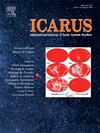Degradation of beta-carotene under mineral thin sections during proton irradiation monitored in situ by Raman spectroscopy
IF 3
2区 物理与天体物理
Q2 ASTRONOMY & ASTROPHYSICS
引用次数: 0
Abstract
More than 3.5 billion years ago, the surface of Mars experienced habitable conditions compatible with the emergence and development of primitive microbial life. Consequently, in the absence of plate tectonics, ancient biosignatures dating back several billion years could still be present at the surface of the red planet. Nevertheless, Mars has been continuously exposed to UV radiation and solar and galactic cosmic rays, which may have degraded these putative biosignatures at the surface over time. The European Space Agency's ExoMars Rosalind Franklin mission, expected to land on Mars in 2030, is thus equipped with a drill to collect samples up to 2 m deep to increase the chances of detecting well preserved molecules.
Here, based on previous models, we first estimate the dose delivered in the first meters of Mars regolith over geological time. We then describe experiments in which beta-carotene (a pigment commonly used by microorganisms) was irradiated using a 2.8 MeV proton beam and its degradation with increasing dose studied by Raman spectroscopy, using a unique device allowing in situ measurements to be carried out within the irradiation chamber. Specific sample preparation, consisting of placing a thin mineral layer on top of the pigment, was also developed to take into account the dose distribution profile within the sample. Finally, based on the dose estimated for Mars, we correlate the change in the Raman signal-to-noise ratio of beta-carotene to an equivalent depth and time on Mars.
利用拉曼光谱原位监测质子辐照下矿物薄片下β -胡萝卜素的降解
35亿多年前,火星表面的适宜居住条件与原始微生物生命的出现和发展相适应。因此,在没有板块构造的情况下,数十亿年前的古代生物特征仍然可能存在于这颗红色星球的表面。然而,火星一直暴露在紫外线辐射、太阳和银河宇宙射线下,随着时间的推移,这些可能会削弱火星表面这些假定的生物特征。因此,欧洲航天局的“罗莎琳德·富兰克林”火星探测任务(ExoMars Rosalind Franklin mission)预计将于2030年登陆火星,它配备了一个钻头,可以收集深达2米的样本,以增加探测到保存完好的分子的机会。在这里,基于以前的模型,我们首先估算了地质时期火星表层最初几米的辐射剂量。然后,我们描述了使用2.8 MeV质子束照射β -胡萝卜素(微生物常用的一种色素)的实验,并通过拉曼光谱研究了其随剂量增加的降解情况,使用了一种独特的装置,允许在照射室内进行原位测量。特定的样品制备,包括在颜料上放置一层薄薄的矿物层,也被开发出来,以考虑样品内的剂量分布。最后,根据估计的火星剂量,我们将β -胡萝卜素的拉曼信噪比的变化与火星上的等效深度和时间联系起来。
本文章由计算机程序翻译,如有差异,请以英文原文为准。
求助全文
约1分钟内获得全文
求助全文
来源期刊

Icarus
地学天文-天文与天体物理
CiteScore
6.30
自引率
18.80%
发文量
356
审稿时长
2-4 weeks
期刊介绍:
Icarus is devoted to the publication of original contributions in the field of Solar System studies. Manuscripts reporting the results of new research - observational, experimental, or theoretical - concerning the astronomy, geology, meteorology, physics, chemistry, biology, and other scientific aspects of our Solar System or extrasolar systems are welcome. The journal generally does not publish papers devoted exclusively to the Sun, the Earth, celestial mechanics, meteoritics, or astrophysics. Icarus does not publish papers that provide "improved" versions of Bode''s law, or other numerical relations, without a sound physical basis. Icarus does not publish meeting announcements or general notices. Reviews, historical papers, and manuscripts describing spacecraft instrumentation may be considered, but only with prior approval of the editor. An entire issue of the journal is occasionally devoted to a single subject, usually arising from a conference on the same topic. The language of publication is English. American or British usage is accepted, but not a mixture of these.
 求助内容:
求助内容: 应助结果提醒方式:
应助结果提醒方式:


